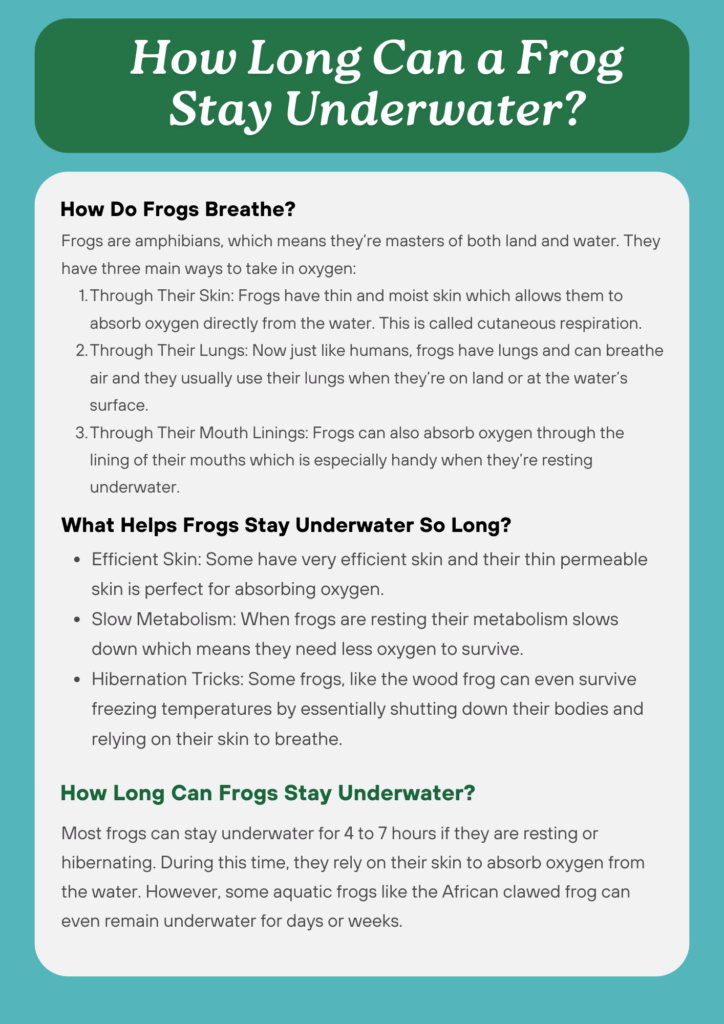Have you ever wondered how long frogs can stay underwater? Lets discover the science behind frog breathing and their underwater abilities and what makes them such amazing swimmers.
Frogs are one of the nature’s most fascinating creatures. But one of their coolest tricks is their ability to stay underwater for like surprisingly long period of time.
If you’ve ever watched a frog disappear beneath the surface of a pond and wondered, “How long can they stay down there?” You are at the right place because now we’re gonna hop into the details and uncover the secrets of frog breathing.
How Do Frogs Breathe?
Now to understand the main thing how long frogs can stay underwater we need to look at how they breathe.
Frogs are amphibians, which means they’re masters of both land and water. They have three main ways to take in oxygen:
- Through Their Skin: Frogs have thin and moist skin which allows them to absorb oxygen directly from the water. This is called cutaneous respiration.
- Through Their Lungs: Now just like humans, frogs have lungs and can breathe air and they usually use their lungs when they’re on land or at the water’s surface.
- Through Their Mouth Linings: Frogs can also absorb oxygen through the lining of their mouths which is especially handy when they’re resting underwater.
How Long Can Frogs Stay Underwater?
Most frogs can stay underwater for 4 to 7 hours if they are resting or hibernating. During this time, they rely on their skin to absorb oxygen from the water. However, some aquatic frogs like the African clawed frog can even remain underwater for days or weeks.
But most of time, frogs are swimming or hunting and they only stay underwater for couple minutes before coming back to the surface.

What Helps Frogs Stay Underwater So Long?
Now you may be wondering that what helps frogs to stay underwater for so long? Its because some frogs have incredible adaptations like:
- Efficient Skin: Some have very efficient skin and their thin permeable skin is perfect for absorbing oxygen.
- Slow Metabolism: When frogs are resting their metabolism slows down which means they need less oxygen to survive.
- Hibernation Tricks: Some frogs, like the wood frog can even survive freezing temperatures by essentially shutting down their bodies and relying on their skin to breathe.
Can Frogs Drown?
Yes its funny but yeah frogs can drown if they’re unable to get to the surface for air or if the water doesn’t have enough oxygen. This is more likely to happen when water is polluted or stagnant. Frogs need a balance of air and water to survive so it’s important to keep their habitats clean.
How to Help Frogs Survive Underwater
If you’re a fan of frogs and want to help them out, here are a some of the tips that you can follow like:
- Keep Water Clean: Frogs need clean water to survive. Avoid polluting ponds or streams.
- Create Frog Friendly Habitats: Add plants and rocks to your garden pond to give frogs places to hide and breathe.
Fun Frog Facts
- Tadpoles: Baby frogs also known as tadpoles have gills and live entirely underwater until they grow into adults.
- Frog Hibernation: Some frogs hibernate underwater during the winter, burying themselves in mud to stay warm and moist.
- Skin Secrets: A frog’s skin isn’t just for breathing it also helps em regulate their body temperature and protects them from predators.
Conclusion
In the end, I would conclude this by saying that the length of time a frog can stay underwater depends on very factors like species as we talked about the African frogs, environment plays a vital role, and also their respiration method.
While some frogs can only remain submerged for a few minutes, others can survive for hours or even weeks through respiration.

